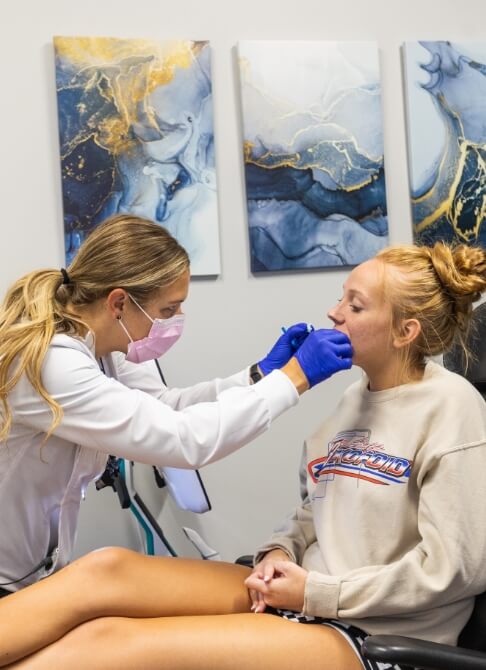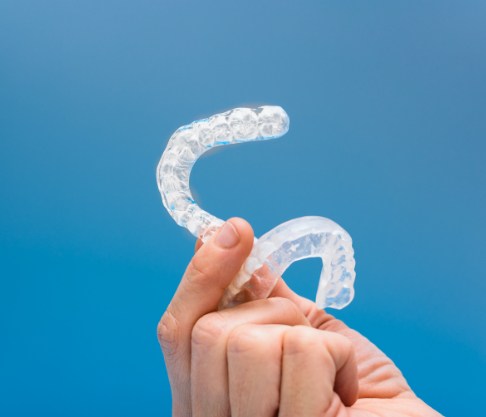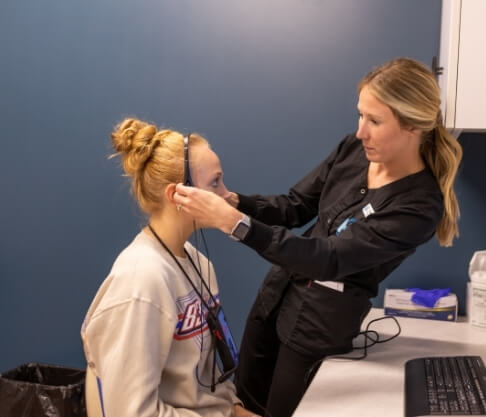

TMJ dysfunction, also commonly referred to as TMD, is a serious issue that involves an imbalance and improper function of the two joints that hinge your lower jawbone to your skull, known as the temporomandibular joints. When left unchecked, this issue can put you at a higher risk of experiencing grinding and clenching as you rest, damaged teeth, and other serious problems. That’s why we recommend visiting our dental office for TMJ therapy in Mankato, MN if you’re experiencing any symptoms of TMJ dysfunction.

TMJ dysfunction is crucial to diagnose, so you can seek out treatment before permanent harm comes to your mouth. We have several different advanced instruments, like our cone beam CT scanner, that help us view the entire facial structure and make detailed treatment plans to ease our patients’ head, neck, and jaw pain.

Occlusal splints are orthotic guards to help take pressure off of your jaw joints and provide them with much-needed relief as you rest, minimizing your symptoms over time. We offer a unique design of TMD guard for clenching and grinding and have special technology that allows us to measure the clicking and popping that occurs in the jaw. We can even combine certain therapies with orthodontic appliances if your condition is a result of bite misalignment.

Do you have questions about TMD diagnoses or treatments? Our team at Hyland Dental is happy to help you get the answers you need to find relief. Below, we’ve compiled some of the most common questions we receive from our patients. If you don’t see the answers you’re looking for, please call us directly.
Minor cases of TMD can work themselves out over time, but if your symptoms are beginning to impact your day-to-day life, visiting a professional for treatment is the only way to relieve your symptoms. While using an occlusal splint each night can help ease tension and stress in the joints, it requires long-term use to cause your symptoms to fade. However, some instances in which your TMD are caused by bite misalignment may require orthodontic treatment like braces to provide you with lasting, permanent relief. It really all depends on the underlying cause of your jaw pain.
As mentioned above, certain cases of TMD can be treated with orthodontic treatment like clear aligners or traditional braces. However, it all depends on the underlying cause of your jaw pain. If your joints and facial muscles are experiencing additional tension and pressure due to a bite problem like underbite, overbite, or crossbite, orthodontics may be the best solution to providing you with permanent relief.
Occlusal splints are an ongoing therapy to help with TMJ pain and must be worn every night to be effective. Over time, you’ll likely notice that your symptoms diminish as your jaw’s position is continuously corrected as you sleep, but it’s still important to continue wearing it. After about six months, most patients using occlusal splints are able to resolve their discomfort, but this isn’t the case for everyone and depends on the severity of your condition.
Common symptoms of TMJ disorder can vary from person to person but often include jaw pain or tenderness, difficulty opening or closing your mouth, and clicking or popping sounds when you chew or speak. Some patients also experience headaches, earaches, or pain that spreads to the neck and shoulders. You might also notice your jaw locking or feeling like it’s stuck. These symptoms can make daily life very uncomfortable; this means that if you experience any of them, you shouldn’t hesitate to contact our office for an evaluation so we can determine the right course of treatment for you.
TMJ treatment with an occlusal splint is generally comfortable and totally non-invasive. The goal of the splint is to relieve pressure on your jaw joints and the nearby muscles—so these devices are designed to correct pain, not cause more of it! When first wearing your custom-made splint, you may notice some mild soreness or an adjustment as your jaw adjusts, but this typically fades within a few days. If your device ever does become uncomfortable to wear, don’t hesitate to contact us at once so we can correct the issues and ensure it continues to help you with your symptoms.
The length of TMJ treatment varies depending on the severity of your symptoms and how long it takes for your jaw to respond to wearing your occlusal splint. For many patients, they notice improvement within just a few weeks, while full relief may take several months of consistent use. Our team will closely monitor your progress and adjust your treatment plan as needed to ensure the best results. However, remember that since every patient’s jaw is unique, treatment times can vary, and it is only by regularly wearing your splint that you can experience consistent and non-delayed results.
Dental insurance coverage for TMJ treatment can vary depending on your plan and provider. Some policies may cover certain aspects of treatment, such as diagnostic exams or occlusal splints, while others may classify TMJ treatment as a medical rather than a dental issue. This is why it’s always best to review your policy or contact your insurance company for details about your specific coverage before committing to any type of treatment. Our team is happy to help you navigate your insurance benefits, provide cost estimates, and work with your provider to make your TMJ treatment as affordable and stress-free as possible!